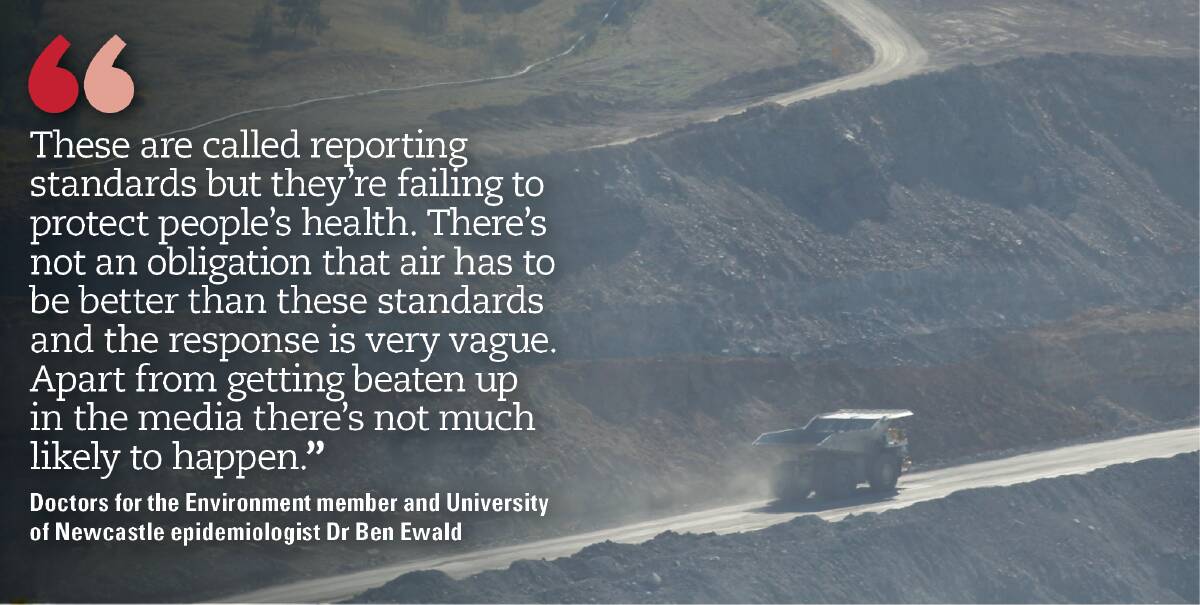
DOCTORS have slammed the Hunter’s air quality regime as “trivial”, “sloppy”, “inadequate”, “ineffective” and “failing to protect human health” after a weekend of national air quality standard exceedances linked to dust from coal mines.
Subscribe now for unlimited access.
$0/
(min cost $0)
or signup to continue reading
Doctors for the Environment members said NSW Government assurances of rigorous conditions and monitoring of Hunter coal mines were exposed as empty words after hot, windy conditions left Jerrys Plains with coarse particle pollution figures that breached national 24-hour standards on Saturday.
This was despite Yancoal’s nearby Mount Thorley Warkworth and Hunter Valley Operations mines shutting down dragline, excavator and truck operations for hours at a time because of strong winds pushing dust towards the village.
“What happens when there are air quality exceedances? Nothing,” said Doctors for the Environment member and University of Newcastle epidemiologist Dr Ben Ewald.
“These are called national reporting standards but they’re failing to protect people’s health. There’s no obligation for air to be better than these standards and the response is very vague. Apart from getting beaten up in the media there’s not much likely to happen.
“In Muswellbrook there have been fine particle exceedances ever since the national reporting standards were established, and that’s the more serious health problem because of impacts on human health, but again, nothing happens when there’s exceedances.”
He said a $15,000 fine for BHP Billiton last week after a dust pollution incident at Muswellbrook’s Mount Arthur coal mine in late 2017 was “trivial and shows a lack of serious intent on the part of the Environment Protection Authority”.
Doctors for the Environment member, rheumatologist and University of Newcastle lecturer John Van Der Kaalen said the Hunter’s weekend figures were worth noting because they weren’t unusual, and showed that standard summer conditions regularly led to exceedances without consequences.
In Jerrys Plains on Saturday hourly air quality data showed strong winds from 5pm pushed air quality to poor after a day of fluctuating hourly figures, with an air pollution health alert for sensitive groups including the young, the elderly and asthmatics.
The EPA confirmed the daily average PM10 level peaked at 52.1 micrograms per metre cubed at Jerrys Plains. The National Environment Protection Measure standard is 50 micrograms per metre cubed.
When you look at how much land has been disturbed and the great piles of earth that’s exposed you can see how strong, dry winds can have a terrible impact on air quality.
- Doctors for the Environment member Dr John Van Der Kaalen
On Saturday evening hourly Jerrys Plains readings were over 100 micrograms per metre cubed.
“It is terrible. When you look at how much land has been disturbed and the great piles of earth that’s exposed you can see how strong, dry winds can have a terrible impact on air quality,” Dr Van Der Kaalen said.
“These huge mines are proposing to expand further. People argue and argue and argue about the cumulative impacts of all these mines and it is time for a proper health study. We haven’t had one for over 10 years and it’s begging to be done.”
Dr Van Der Kaalen and Dr Ewald said inclusion of coal mining in the NSW load-based licensing scheme – where companies pay a fee per tonne for pollution generated – would be one of the quickest and most effective ways of quantifying the true cost of coal-related air pollution in the Hunter.
In a submission to the government’s review of the scheme Doctors for the Environment said mining’s exclusion from the existing scheme was the most glaring example of substantial polluters “getting away free” and “unfairly leaving other industries to pay for pollution”.
Mining is the biggest emitter of fine particle PM2.5 pollution and the dominant source of coarse particle PM10 pollution.
Public interest legal practice Environmental Justice Australia said there was no reason why coal mines should be exempted from the scheme. The group strongly criticised the EPA’s $15,000 fine for Mount Arthur after Muswellbrook mayor Martin Rush last week said current environmental laws did not protect Hunter communities.
“If Mount Arthur was to pay a fee based on their PM10 and other toxic emissions and the fee was based on health impacts, that would be a genuine deterrent,” an Environmental Justice Australia spokesperson said.
Dr Ewald said the state’s environmental regulatory system needed real penalties and mines “should be designed so that they don’t encroach on where people are living and don’t impact people to the point of threatening their health” but “that’s not the system we have at the moment”.
”We’re told there are rigorous conditions and monitoring of mines but the system we have is very sloppy and prioritises mines rather than human health,” Dr Ewald said.
Mount Thorley Warkworth and Hunter Valley Operations reports on weekend operations showed both mines repeatedly stopped operating major machinery because of high wind and dust conditions from as early as shortly after midnight on Saturday, with three draglines at Mount Thorley Warkworth “parked up” on and off for hours from 3.28pm.
At Hunter Valley Operations dust and wind stopped graders, excavators and loaders from operating from 3.30pm, with the first dragling “parked up” because of dust and wind at 6pm.
The EPA said it contacted a number of mines on Friday and Monday for information about “action taken to implement best practice dust emissions controls over last Friday and Saturday to review compliance against the licence conditions”.
“The EPA and Office of Environment and Heritage recently completed a trial, in cooperation with Hunter Valley mines, of a dust risk forecasting model to identify periods of high dust risk,” the EPA said.
“More accurate forecasting of the risk of high dust emissions from coal mining activities will provide another tool for mines to use to implement best practice dust mitigation.”
The air quality monitoring network was not a regulatory tool but a scheme “to provide information to the local communities on air quality”.

